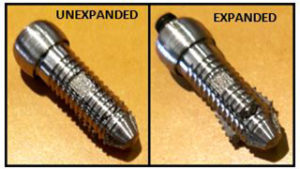Expandable orthopaedic screw
Curtin is seeking partners to support the development and clinical testing of the device and to sell the device under license.
Email: commercialisations@curtin.edu.au
Summary of technology
Screws are used in orthopaedic surgeries to attach implants such as plates and rods to the bone to repair fractures, fuse joints or reattach soft tissues. However, if the bone is low quality, such as osteoporotic, or the fracture is particularly severe the screws can loosen, break or pull-out. In these cases, the patient might be injured due to the failed fixation and surgery must be performed again (revised) to replace the failed screws. These problems are particularly prevalent in proximal humerus fracture (shoulder fractures) patients where 14 per cent of general patients require revision surgery and 22 per cent of patients have complications (57 per cent for patients older than 60 years) attributable to poor fastener fixation and fastener malplacement.
Our researchers have developed an innovative expandable screw (EXF), for use in orthopaedic surgery.
Unlike previous expandable screws, the EXF can provide significantly increased fixation strength (up to 90 per cent) compared to equivalent conventional screws without compromising removability and with minimal change to the surgeon’s operating procedure.
Superior mechanical performance can potentially reduce the risk of long-term clinical failure, allow a reduction in screw length to reduce surgical risk and allow earlier rehabilitation. This results in improved patient outcomes and reduced revision rates, culminating in reduced cost to the payer – a healthcare provider or insurance companies.
The EXF is designed for fixation into the spongy area of the bone (cancellous bone) such as the ends of long bones and spinal vertebral body. The EXF can be designed to any diameter from 4 mm and varying length from 10 mm. There is also an opportunity to include multiple expansion points along the length of the EXF design when designing long EXF devices.
The EXF (see Figure 1) is inserted, by an orthopaedic surgeon, into a drilled hole in the bone of the patient, in the same manner as a conventional screw. Then an expansion bolt is screwed into the core of the EXF to expand the device. The EXF could be used in low-quality osteoporotic bone, such as in older patients, to provide a reduced risk of fastener failure and in normal bone with a reduced length to reduce or eliminate the risk of over-penetrating the bone, which can be critical in certain applications.

Figure 1: An EXF prototype, manufactured from titanium through 3D printing, with an expansion bolt screwed into the core of the EXF to expand the device.
Applications
The EXF is a platform technology that can be adapted to suit many different applications throughout the body. A list of applications for the EXF technology in order of entry stages are listed below:
- Proximal humerus fracture fixation.
- Anterior cervical fusion.
- Posterior lumbar fusion.
- Proximal femur fracture fixation.
Advantages
Screws are the conventional fastener used in orthopaedic surgery, accounting for more than 95 per cent of the fasteners used in orthopaedic surgeries. They are consequently the primary competitors of the EXF. There are a number of other orthopaedic expandable screws on the market, however, there are, to our knowledge, no expandable fasteners being developed for proximal humerus fracture fixation (our primary target indication) and the adoption of expandable screws has been limited due to the fact that they cannot be easily removed once implanted.
The EXF has several advantages over currently available conventional and expandable screws:
- a stronger fixation strength
- the bond between bone and implant surface is more effective and occurs earlier
- easily removable during revision surgery.
Superior fixation strength will:
- reduce the risk of clinical failure and subsequently the risk of a costly and traumatic revision surgery
- allow surgical treatment of patients with a low-quality bone (osteoporotic, elderly patients) who would otherwise have to be conservatively managed due to the likelihood of screw failure
- allow a reduction in screw length to reduce or eliminate the risk of over-penetration into the shoulder joint or spinal cord, necessitating a revision surgery
- allow earlier rehabilitation resulting in improved patient outcome.
Intellectual property
A provisional patent to protect the specific design features to allow large expansion of the EXF was filed in February 2014 and PCT application was filed in February 2015 and published as WO 2015/123726.
A second provisional patent to protect the specific design features to allow removability of the EXF was filed in March 2016.
Development team
The research team consists of Biomedical Engineering PhD candidates Matthew Oldakowski and Intan Oldakowska, supervised by Professor Brett Kirk. Professor Philip Hardcastle, an orthopaedic surgeon and inventor of the very successful STALIF and STALIF-C implants (Centinel Spine), devised the concept. Providing clinical advice are Professor Markus Kuster, a world-leading orthopaedic surgeon and the inventor of the very successful Zimmer, Non-Contact Bridging (NCB) plating system, and Professor Gabriel Lee, a well-respected Neurosurgeon at St John of God Hospital. Ian Brown, an experienced and successful entrepreneur, has been engaged as a commercialisation consultant to the project.
Stage of development
The EXF is at a proof-of-concept stage with further mechanical testing underway. Preliminary testing of the technology in ovine vertebral body and synthetic bone model has shown a 41 per cent and 92 per cent increase in fixation strength respectively and a functional prototype has been developed. Further testing required to achieve regulatory approvals include benchtop testing, an animal study and first-in-human clinical testing (10–20 patients).